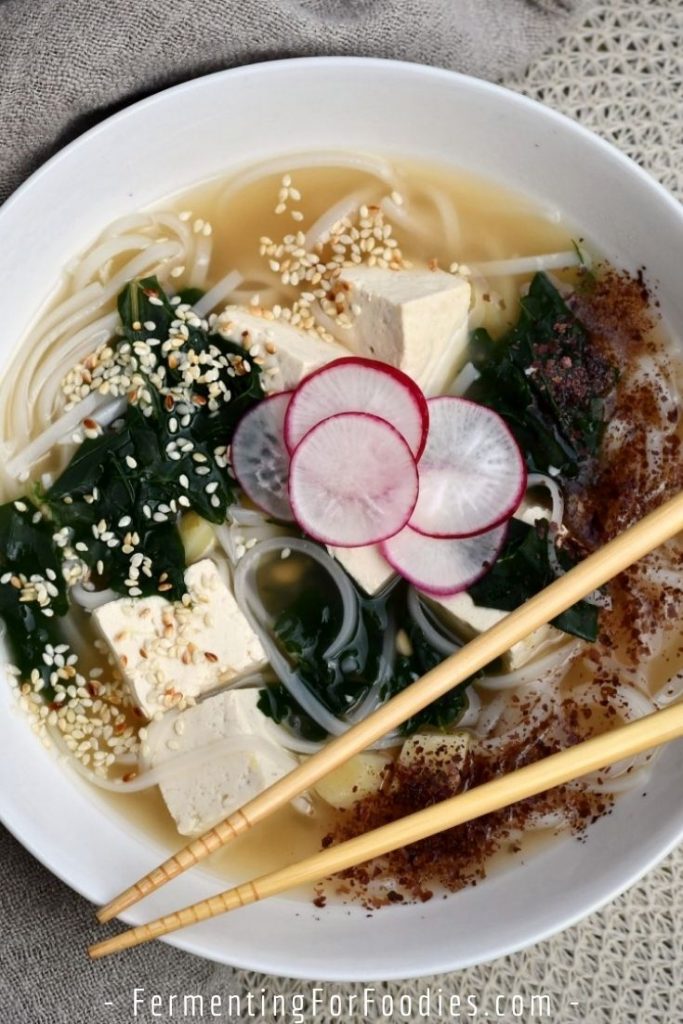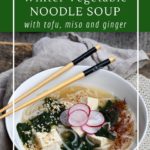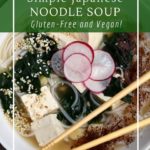Looking for a quick and healthy weeknight meal? This Japanese noodle soup is warm, rich, and filling. It’s a simple one-pot meal that is ready in around 30 minutes. Perfect for a busy day!

I have chosen to feature parsnips and kale in the recipe. Not only are they locally available in the winter, but they also provide a balance of sweet and bitter flavors that is absolutely delicious. However, this basic noodle bowl is perfect for whatever vegetables are in season where you live!
Mix and Match Toppings
I love recipes that allow for flexibility and experimentation. I created this recipe to work with whatever vegetables come in my weekly farm box.
Naturally a gluten-free and vegan recipe, this soup can be turned into a keto meal by replacing the noodles.
Here are some suggested substitutions:
- Noodles:
- Use soba, ramen, or udon noodles for a traditional Japanese noodle soup.
- Kelp noodles are a great keto alternative.
- Protein: The recipe is meant to make 4 servings, so use enough protein to serve four people. It’s also fun to mix multiple types of protein.
- Boiled eggs are delicious in this soup. I like 7-minute eggs, which have slightly soft yolks.
- Use strips of cooked chicken, beef, or pork.
- Even a handful of roasted peanuts tossed on top will give an extra dose of protein.
- Vegetables: Really any combination of fresh vegetables will work in this soup. The only trick is to cook the vegetables until they are soft but not mushy. Add the harder vegetables first (like the parsnips in this recipe), then add the softer vegetables with the noodles.
- Good alternative vegetables include carrots, mushrooms, broccoli, snow peas, cabbage, or Asian greens.
- Garnish with Japanese-style pickles.
Japanese Noodle Soup
This soup starts with a rich miso broth which provides a base for all your favorite toppings. It is the perfect soup for a busy weeknight as it is quick to prepare and can be made from whatever you have in your fridge! See the section above for alternative flavor combinations.
- Prep Time: 10 minutes
- Cook Time: 20 minutes
- Total Time: 30 minutes
- Yield: Serves 4-6 1x
- Category: Soup
- Cuisine: Japanese
- Diet: Vegetarian
Ingredients
Broth:
- 4 garlic cloves
- 2-inch piece of ginger
- 1 large piece of kombu
- 12 cups of water
- 1/4 cup of soy sauce (or GF tamari)
- 1/2 cup of miso paste (stir in at the end)
- 1 1/4 tsp salt, to taste
Remaining Ingredients:
- 1 lb. flat rice noodles
- 1/2 lb. of parsnips (3 small or 1 large)
- 1 bunch of kale
- 1 block of tofu (1 lb.)
Garnishes:
- Sprinkle of toasted sesame seeds
- Dulse flakes
- Sliced spring onions
- Thinly sliced radishes
Instructions
- Dice the garlic. Peel and grate the ginger.
- Combine all the broth ingredients except for the miso and salt in a large pot. Bring to a boil then reduce to a simmer.
- Peel and cube the parsnips. Add to the simmering broth, and cook for 10 minutes.
- While the parsnips cook, wash and rip the kale into bite-sized pieces. Slice the tofu into small cubes.
- After 10 minutes of simmering, add the kale, tofu, and noodles to the broth. Turn off the soup and let the noodles cook until tender (about 6 minutes for rice noodles.)
- As the noodles cook, remove about 1 cup of water. Stir the miso into the water to fully dissolve. Add the miso to the soup pot. Taste a little bit of the broth, and add salt, as necessary.
- Serve immediately, topping each bowl with a few fresh garnishes.
Notes
- While I’ve written this recipe using parsnips and kale, it really can be served with all sorts of vegetables. It’s also designed to suit all sorts of diets. Use gluten-free noodles for a gluten-free diet, and skip the noodles altogether for a keto meal. See the section above for some suggested combinations.
- The easiest substitutions for parsnips and kale are carrots and spinach. However, I’ve made this soup with everything from fresh peas and sweet peppers to broccoli. It really is a good, all-purpose soup.
- Adding miso at the end gives the soup a probiotic boost. Homemade miso is always probiotic. Miso in the refrigerated section of your grocery store is also usually alive. Just don’t add the miso until the broth has cooled slightly otherwise you risk cooking the culture.
Nutrition
- Serving Size: 2 cups
- Calories: 273
- Sugar: 4.2g
- Fat: 8.1g
- Carbohydrates: 35.9g
- Fiber: 5.4g
- Protein: 17.1g






Do the noodles cook in the hot broth when the heat has been turned off? The recipe isn’t very clear…
Rice noodles will cook in the hot broth after the heat has been turned off. However, if you are using soba noodles, you may need to add them to the simmering broth. Follow the directions on the noodle package. Thanks for letting me know about the confusion. I’ll take another look at the recipe try to make it clearer. Cheers, Emillie
I love this recipe! It’s very fast to make.
It’s a good busy night dinner! Cheers, Emillie